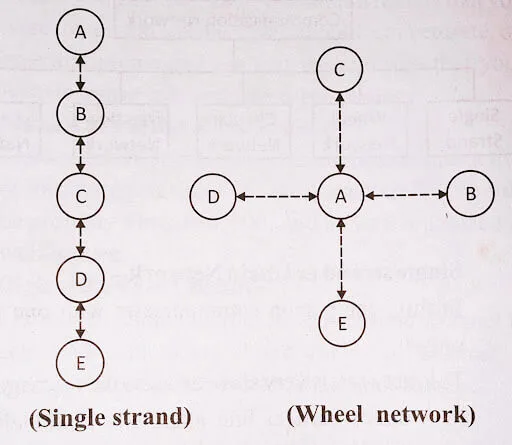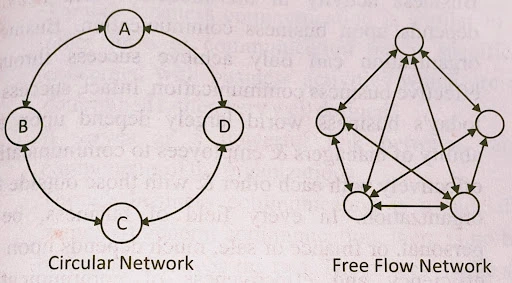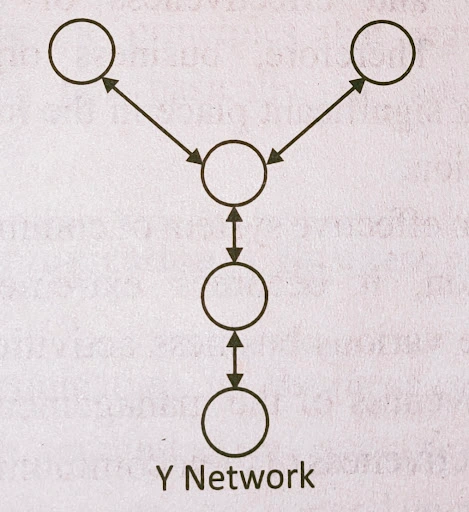A communication network represents the pattern of contacts among the individuals who make up an organization. The primary determining factors are the types of communication networks and the number of participants in the process.
5 Different Types of Communication Networks

1. Single Strand or Chain Network
In this, a single person converses with just that one person.
- Because of the scalar chain of command’s direct vertical message flow, this network operates relatively slowly.
- It can move in a straight line from top to bottom or from bottom to top. It is one of the types of communication networks.
- As a result, communication occurs through official channels, such as from superior to subordinate and vice versa.
- In the chain network, there is no horizontal communication.

2. Wheel Communication Network
The wheel network represents the communication pattern that allows subordinates to communicate with and through one management.
All communications must go via the manager, who serves as the network’s central authority and resembles the hub of a wheel, hence the name “wheel network.”
3. Circular Communication Network
The message circulates in a circle in a circular network. A circular network’s main drawback is that communication takes longer. Only two neighbors can communicate with each other at a time.

4. Free Flow Communication Network
The flow of information is unrestricted in such an organizational structure and organizational appraisal.
- Everyone in the company is allowed to communicate with anyone and everyone else.
- This network is either unstructured or informational.
- It’s incredibly adaptable.
5. Y Communication Network
Information moves in this centralized network via predetermined paths. These networks might be suitable for straightforward tasks requiring little interaction between group members.

As most people belong to many networks, different networks emerge in real life. The financial manager, for instance, might be at the hub of a chain and involved in the wheel and circle networks. As a result, modern enterprises use a variety of network arrangements.
What are the Different Types of Communication Networks?
here are several sorts of communique networks commonly used in corporations. Here are three fundamental sorts:
1. Centralized Network: In a centralized community, all verbal exchange flows thru a vital character or institution. This significant figure serves as a hub, receiving and disseminating information to other participants. It is a hierarchical structure wherein communication follows a pinnacle-down technique.
2. Decentralized Network: A decentralized community permits multiple conversation paths, allowing individuals or organizations to speak immediately with every different. It promotes collaboration, information sharing, and faster selection-making. It is regularly visible in corporations that cost flexibility and autonomy.
3. Network of Teams: This form of verbal exchange network entails go-practical teams working collectively on specific initiatives or tasks. Communication happens within every crew and throughout groups, facilitating collaboration, knowledge sharing, and coordination.
What is a Network of Teams and its Advantages?
A community of groups refers to a communique community in which cross-purposeful teams paintings together on particular projects or tasks. Here are three advantages of a community of teams:
1. Cross-Functional Collaboration: A network of teams enables collaboration and conversation among people from particular functional areas within an organization. This complements the move-pollination of thoughts, numerous expertise, and a holistic technique to problem-solving.
2. Knowledge Sharing and Getting to Know: By working in a community of groups, individuals can share knowledge, satisfactory practices, and instructions discovered from their respective regions of understanding. This ends in continuous getting-to-know and development throughout the employer.
3. Efficient Aid Allocation: A community of groups permits green aid allocation by assembling teams with vital talents and information for unique projects. It ensures that sources are applied efficaciously and aligned with mission requirements.
How can Organizations Determine the Most Suitable Communication Network?
To determine the maximum suitable verbal exchange network, groups need to don’t forget the subsequent elements:
1. Organizational Shape: The organizational shape performs an extensive position in determining the appropriate communication network. Centralized networks are more appropriate for hierarchical structures, while decentralized networks can align higher with flatter organizational systems.
2. Nature of Tasks and Projects: The nature of obligations and projects being undertaken should be considered. Complex and interdisciplinary projects also gain from a network of groups, promoting collaboration and information sharing.
3. Organizational Tradition: The present organizational culture and values should be considered. A decentralized network may be more suitable if the company values autonomy, flexibility, and innovation. In evaluation, businesses with a strong emphasis on management and consistency might also lean closer to a centralized community.

